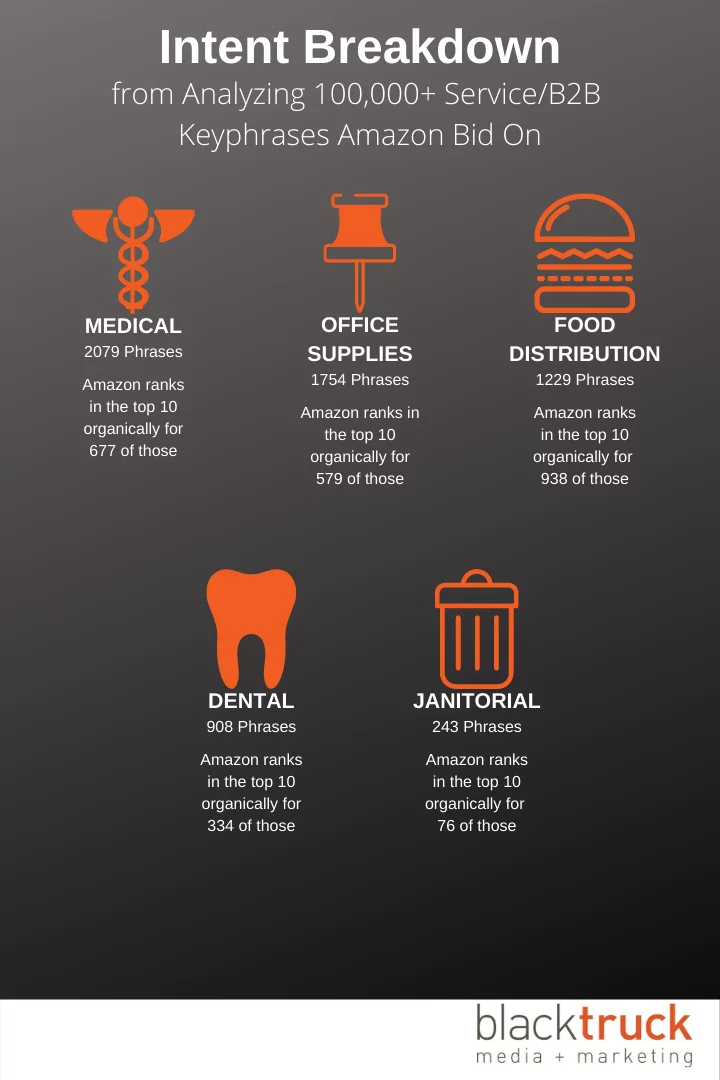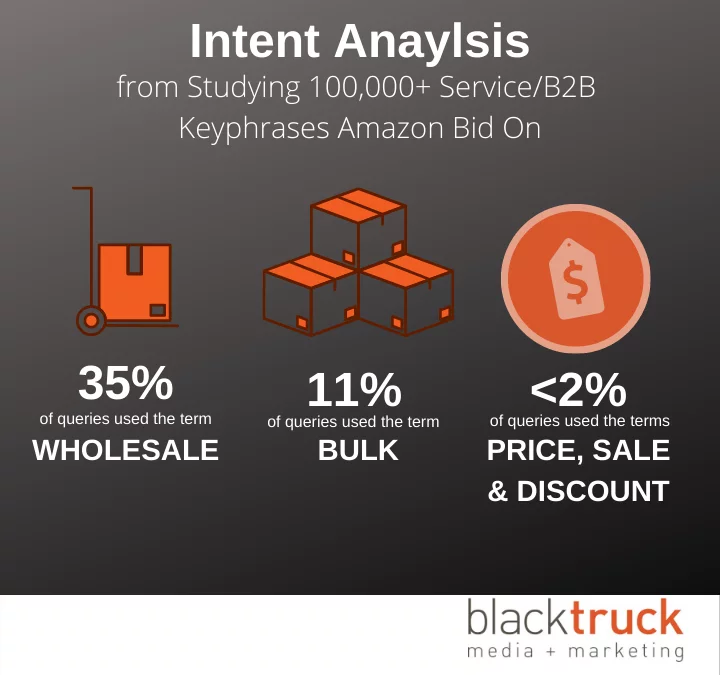In doing some research for a client, who is B2B and service-oriented, we came across something that raised our eyebrows. The business arm of Amazon was bidding on and competing against the same terms that our client was, which is a very specific niche vertical. Keywords that, quite frankly, on the surface it seemed Amazon had no business going after. This breadcrumb led us to hypothesize: what other terms was Amazon bidding on? And why?
As a competitive PPC operative seeking insight and a bit of an edge on another brand, we studied the data. The basis of our study came from multiple sources, pulling data in from SpyFu and cross checking it for organic rank comparisons via the team at Rank Ranger.
For starters, we targeted the Amazon Business vanity domain (amazonbusiness.com) being used by Amazon to promote their wares, and dropped this into one of our favorite applications, SpyFu, and let it churn. Shockingly, the first round kicked back over 60,000 keywords. The second time we did a pull from their database it was just over 120,000 keywords actively being bid on with an estimated budget/media/click worth $500k a month. Note: at the time, they were using amazonbusiness.com, so that is what we originally crawled, but that now redirects to the subdomain (business.amazon.com).
Once you moved past the potential $6M in annual Google Ads dollars spent, what was more eye-opening was the business categories they were going after. Using advanced filters to group keywords, we were able to break these out into smaller bite-sized chunks to have an understanding of what they are doing.
Amazon was not bidding on just the typical items that you are purchasing as a consumer, but they were going after products used primarily by service-based companies. Products that are traditionally purchased via specialty B2B distribution channels (think Grainger, Jon-Don, ULINE, etc). And that’s the key phrase we would like everyone to focus on… “distribution.” Keep in mind… Amazon migrated away from being the worlds largest e-commerce company, to being a dominant player in the distribution market. With warehousing, transportation, and a growing network of business solutions, it was inevitable that this was coming out of the giant.

Wanting to have a better grasp on the market and/or growth potential that Amazon had within its respective business category, an export of the PPC phrase combinations was passed along to the team at Rank Ranger to run through their database in an effort to get some semblance of where exactly Amazon ranked organically for some of these terms.
The Findings?
Interestingly enough, organically, the business.amazon subdomain ranks poorly for many of these commercialized search terms. Amazon.com as the root domain, absolutely has a seat at the table.
The power for Amazon comes with their brand (listen to The Role of SEO in Branding by Sarah Bird at MOZ for a deeper dive into the power of branding). Over time, yes there is benefit in owning or having an opportunity to rank organically for the more top of funnel terms, but the power currently for Amazon is the “Brand + Product.” This building trust with the audience(s) within each business segment is what they’re trying to go after.
Consider this scenario: if you’re an office manager for a multi-office dental clinic and you’re ordering a few supplies anyways from Amazon… wouldn’t you think about placing an auto-order for disposable masks, gloves, and other ancillary products? After all, you trust them with your auto-order of paper towels and cleaning supplies, why not other things? And by doing so, it’s one less supplier you might have to deal with, simplifying your business operations. But it’s also less business for that supplier, which could be you.
What Does It Mean?
Up front, it goes to show that any business can be disrupted by others. Be it a major global online marketplace like Amazon, or a direct-to-consumer sales channel put in play by the manufacturer.
It’s easy to see that Amazon dominates the consumer market. But to date, how many traditional business entities that support a service-based industry are viewing the Amazons and Walmarts of the world as their competition?
Paying attention to the keywords that Amazon is bidding on shows us insight as to what they (or any other competitor for that matter) find important. Sorting those keywords out into different thematic categories allows us to see which markets they could be buying their way into.
Amazon, organically, for many of these speciality B2B categories does not really have a leg to stand on, yet. In theory, if they’re not ranking organically and haven’t built up the brand awareness that “hey we, Amazon, do that!” then they must buy their way in. And they’re willing to pay handsomely for it. This same mindset transcends into your competition too.

Additionally, it’s market research. It might as well be first-person, quantitative research, that if done by any other means would cost them even more. $500k/mo. Spread out across top performing and highly competitive markets, especially on a hyper local level, would cost much more to obtain the level of detail they potentially gathered through search term reports.
Nothing is stopping you or another major competitor from doing so. Unfortunately, we do know that major changes to the Google Search Terms Report will be happening and a major percentage of those terms will be or is going away.
It’s also good to point out that large brands such as Amazon and others, actually run what many of us consider to be a pretty poor paid-search campaign. Based on the information gathered by our team, it largely is broad match or broad match modified terms. This allows them to generate the most data at the lowest CPC, but it also in normal circumstances, is a waste of ad budget.
What should you do if you’re a service-based B2B company?
The speed at which Amazon can move is no different than any other major tech company (we’re looking at you, Google, Facebook). If there is a market they want to explore, spinning up a campaign and going after it to gather test data is not that difficult for Amazon.
But, it also shouldn’t be that difficult for other brands, including yours. Sometimes it just takes a different thought process and a bit of effort to test a market or go toe-to-toe with a competitor, even if said competitor is Amazon.
The elements to remember if you’re within these categories:
- Amazon is a major distribution channel now across markets.
- Amazon has an immense amount of trust.
As the proverbial saying goes, the best offense is a good defense. Beat them at their own game by being proactive and strategic with your marketing, SEO, and content creation and optimization efforts.
Need help with any or all of the above? We’re here.




